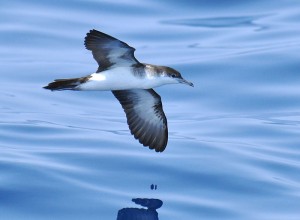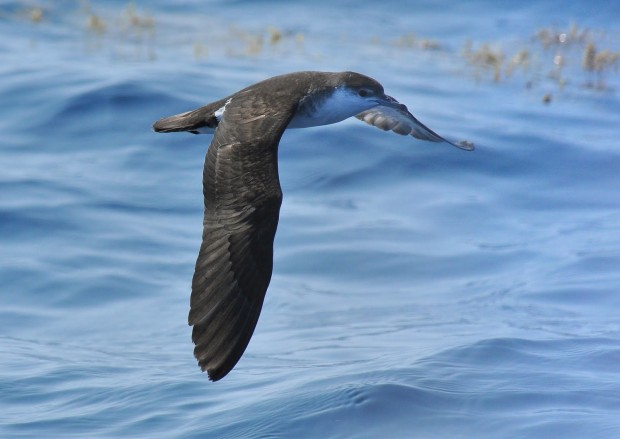Shearwater May Be Returning To Bermuda
 The age of discovery is never over says internationally acclaimed Bermuda ornithologist Dr. David Wingate — reporting the Audobon’s Shearwater may be returning to nest on the island after a decades-long absence.
The age of discovery is never over says internationally acclaimed Bermuda ornithologist Dr. David Wingate — reporting the Audobon’s Shearwater may be returning to nest on the island after a decades-long absence.
In the most recent “Bermuda Audobon Society” newsletter, the island’s former Chief Bermuda Conservation officer said a specimen of the sea-going bird crashed a West End beach party earlier this year.
“A most extraordinary ornithological event took place at a beach party at Nine Beaches, Daniel’s Head,” said Dr. Wingate. “An Audubon’s Shearwater, not confirmed as a nesting species since my last record in the early 1980s was attracted to a floodlight set up for the beach party and after flying back and forth uttering the characteristic courtship calls eventually crashed into a casuarina and fell to the ground.
“Luckily, it was retrieved unhurt by Nigel Pollard, who thought it might be a Cahow — being very similar in appearance and nocturnal behaviour — and he immediately delivered it to the Aquarium where Chief Conservation Officer Jeremy Madeiros and I measured, weighed and photographed it the next day. Jeremy then released it into a crevice on Green Island, Castle Harbour, where Audubon’s used to nest.”
Dr. Wingate — who as a teenager participated in the 1950s expedition which re-discovered the Cahow and later spent most of his career struggling to bring Bermuda’s national bird back from the brink of extinction — said he had the sad experience of watching the last few pairs of Audubon’s Shearwaters on the Castle Harbour islands fade into history.
“Or so I assumed,” he said. “Unlike the Cahow, this species still survives fairly commonly elsewhere, notably in the Caribbean and Bahamas as the nearest points to Bermuda. They range up into the Gulf Stream.
“Also, unlike the Cahow they are much more prone to be attracted to bright lights at night — as witness the event at Nine Beaches –, so I attributed this as one probable cause of their demise on Bermuda because they are nocturnally active on the breeding grounds. For example, in 1963 a fledgling that I watched depart on the night of 13-14 July was found dead the next morning on Ferry Reach, hit by a car.
“On 20 February 1965 an adult Audubon’s was grounded by bright lights at the airport parking lot. I retrieved that bird alive and released it at Cooper’s Point. In Nov. 1968, a Norway Rat killed a pair on Outer Pear islet off Coopers Point. Then just as things were beginning to look hopeless, with three pairs remaining on the Castle Harbour islands I made the incredible discovery of a pair nesting successfully in a cliff crevice on Bermuda’s mainland at Spittal pond on 15 April 1967.
“That pair nested successfully for four years before the nest was found by a cat and one of the adults found eaten on February 8, 1972.
Dr. Wingate said that mainland nest site, and those on the Castle Harbour islets had one feature in common: the crevice entrances were too small to permit entry and take over by Longtails.
He began to wonder how many other cliff crevices along Bermuda’s coastline met that specification and might be supporting other undiscovered pairs of this cryptic nocturnal species.
“In August 1990, Jeremy Madeiros bolstered this thought by finding the recent skeleton of an Audubon’s Shearwater while exploring Great Head cave which is probably inaccessible to cats,” said Dr. Wingate. “Then on the night of 8 May, 1991 while I was living in a cottage on the shoreline of the US Naval Annex — now known as Morgan’s point — I had the memorable experience of hearing the distinctive ‘pimlico, pimlico’ courtship calls of an Audubon’s somewhere close by in the garden.
“I was unable to track it down in the dark before it moved off, but that date is highly significant because it is only a couple of days different from the bird that was caught at Daniel’s Head and matches the time of year when naïve sub-adult birds come in off the ocean for the first time to prospect for nest sites and mates.”
He said there are still unresolved question about the occasional sightings of Audobon’s in recent years — whether they represent relics from a Bermuda population no longer sustainable or spontaneous re-colonisation attempts by birds from the Bahamas’ population.
“If the answer is the former, then it seems entirely possible that an extremely low and widely dispersed relic population of this long-lived seabird still survives although surely unsustainable in the long term,” he said. “If the latter is the case, then Bermuda is an unfortunate sink or death trap for naïve sub-adult
birds that might try to colonise from the Bahamas.
“I throw out this challenge to the local birders to try and prove continued nesting attempts on Bermuda.”
Read More About
Category: All, Environment



I was at Spanish Point today (Sat 15th October) and there were 2 birds flying around that looked like shearwaters. Could have been cahows, I’m not sure because I don’t think I have ever seen a cahow. I have only seen shearwaters previously on the banks.